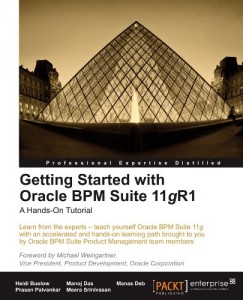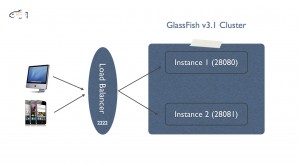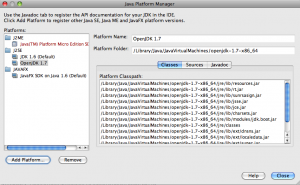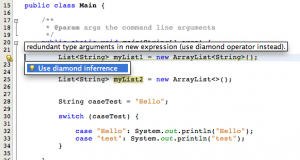Evaluating Coherence on Mac OS X
Posted by Sébastien Stormacq in Java, Oracle on 10/12/2010
Coherence is a in-memory distributed cache system, usually sitting in between your application servers and your databases.
Coherence is designed to be extremely scalable and has no single point of failure.
It was originally developed by TangoSol and acquired by Oracle in March 2007.
Although usually used by large scale Internet web site and transactional system, Coherence happens to be very lightweight and easy to use for evaluation / development.
Coherence is fully developed in Java and runs on any Java-enabled platform, including Solaris, Linux, Windows and Mac OS X. Coherence provides clients libraries for Java, .Net and C++ applications.
In this serie of articles, I will show how to test and evaluate Coherence on a Mac OS X system.
1. Get the package
You can freely download Coherence from Oracle Technology Network (free membership required)
2. Unzip the package
marsu:~ sst$ unzip coherence-java-3.6.0.0b17229.zip
3. Inspect the package and be sure the scripts are executable
marsu:~ sst$ ls coherence bin doc lib product.xml
Without surprises :
- bin – will contains the executable
- doc – contains the javadoc
- lib – contains the JAR to be included with your application
marsu:~ sst$ chmod u+x bin/*.sh
4. Start a first cluster node
marsu:coherence sst$ ./bin/cache-server.sh
Many lines will be output on the console. Be sure to read
Group{Address=224.3.6.0, Port=36000, TTL=4}
MasterMemberSet
(
ThisMember=Member(Id=1, Timestamp=2010-12-10 13:02:01.121, Address=192.168.0.2:8088, MachineId=26626, Location=machine:marsu,process:42007, Role=CoherenceServer)
OldestMember=Member(Id=1, Timestamp=2010-12-10 13:02:01.121, Address=192.168.0.2:8088, MachineId=26626, Location=machine:marsu,process:42007, Role=CoherenceServer)
ActualMemberSet=MemberSet(Size=1, BitSetCount=2
Member(Id=1, Timestamp=2010-12-10 13:02:01.121, Address=192.168.0.2:8088, MachineId=26626, Location=machine:marsu,process:42007, Role=CoherenceServer)
)
RecycleMillis=1200000
RecycleSet=MemberSet(Size=0, BitSetCount=0
)
)
Group{Address=224.3.6.0, Port=36000, TTL=4}
MasterMemberSet ( ThisMember=Member(Id=1, Timestamp=2010-12-10 13:02:01.121, Address=192.168.0.2:8088, MachineId=26626, Location=machine:marsu,process:42007, Role=CoherenceServer) OldestMember=Member(Id=1, Timestamp=2010-12-10 13:02:01.121, Address=192.168.0.2:8088, MachineId=26626, Location=machine:marsu,process:42007, Role=CoherenceServer) ActualMemberSet=MemberSet(Size=1, BitSetCount=2 Member(Id=1, Timestamp=2010-12-10 13:02:01.121, Address=192.168.0.2:8088, MachineId=26626, Location=machine:marsu,process:42007, Role=CoherenceServer) ) RecycleMillis=1200000 RecycleSet=MemberSet(Size=0, BitSetCount=0 ) )
And … that’s it. The first cluster node is started.
5. Start a second cluster node
In another terminal, type :
marsu:~ sst$ cd coherence marsu:coherence sst$ ./bin/cache-server.sh
In the output, be sure to read
MasterMemberSet ( ThisMember=Member(Id=2, Timestamp=2010-12-10 13:05:16.693, Address=192.168.0.2:8090, MachineId=26626, Location=machine:marsu,process:42023, Role=CoherenceServer) OldestMember=Member(Id=1, Timestamp=2010-12-10 13:02:01.121, Address=192.168.0.2:8088, MachineId=26626, Location=machine:marsu,process:42007, Role=CoherenceServer) ActualMemberSet=MemberSet(Size=2, BitSetCount=2 Member(Id=1, Timestamp=2010-12-10 13:02:01.121, Address=192.168.0.2:8088, MachineId=26626, Location=machine:marsu,process:42007, Role=CoherenceServer) Member(Id=2, Timestamp=2010-12-10 13:05:16.693, Address=192.168.0.2:8090, MachineId=26626, Location=machine:marsu,process:42023, Role=CoherenceServer) ) RecycleMillis=1200000 RecycleSet=MemberSet(Size=0, BitSetCount=0 ) )
6. Troubleshooting startup issues
By default, Coherence uses multicast to communicate between servers. In some rare cases, Multicast might fail, preventing the second node to join the cluster.
Be sure to check the documentation and these troubleshooting notes if you run into a problem.
7. Using the cache interractively
Coherence has a command line interface to manipulate objects in the cache,
marsu:coherence sst$ ./bin/coherence.sh ** Starting storage enabled console ** (many lines suppressed) 2010-12-10 13:26:02.066/1.264 Oracle Coherence GE 3.6.0.0 <D5> (thread=Invocation:Management, member=3): Service Management joined the cluster with senior service member 1 Map (?):
Let’s first create a cache :
Map (?): cache currencies 2010-12-10 13:31:30.019/329.217 Oracle Coherence GE 3.6.0.0 <Info> (thread=main, member=3): Loaded cache configuration from "jar:file:/Users/sst/coherence/lib/coherence.jar!/coherence-cache-config.xml" 2010-12-10 13:31:30.151/329.350 Oracle Coherence GE 3.6.0.0 <D5> (thread=DistributedCache, member=3): Service DistributedCache joined the cluster with senior service member 1 <distributed-scheme> <scheme-name>example-distributed</scheme-name> <service-name>DistributedCache</service-name> <backing-map-scheme> <local-scheme> <scheme-ref>example-binary-backing-map</scheme-ref> </local-scheme> </backing-map-scheme> <autostart>true</autostart> </distributed-scheme> Map (currencies): Map (?): cache currencies2010-12-10 13:31:30.019/329.217 Oracle Coherence GE 3.6.0.0 <Info> (thread=main, member=3): Loaded cache configuration from "jar:file:/Users/sst/coherence/lib/coherence.jar!/coherence-cache-config.xml"2010-12-10 13:31:30.151/329.350 Oracle Coherence GE 3.6.0.0 <D5> (thread=DistributedCache, member=3): Service DistributedCache joined the cluster with senior service member 1<distributed-scheme> <scheme-name>example-distributed</scheme-name> <service-name>DistributedCache</service-name> <backing-map-scheme> <local-scheme> <scheme-ref>example-binary-backing-map</scheme-ref> </local-scheme> </backing-map-scheme> <autostart>true</autostart></distributed-scheme> Map (currencies):
Populate the cache :
Map (currencies): put USD "US Dollar" null Map (currencies): put EUR "Euro" null Map (currencies): put CHF "Swiss Franc" null Map (currencies): put GPB "British Pound" null
Play with the cache :
Map (currencies): size 4 Map (currencies): get CHF Swiss Franc Map (currencies): remove CHF Swiss Franc Map (currencies): size 3 Map (currencies): list GPB = British Pound USD = US Dollar EUR = Euro
8. Next Step
In the next article, I will show you how to programmatically interact with Coherence from a Java application.
Out of the box integration
Posted by Sébastien Stormacq in Oracle on 09/12/2010
 |
One year ago, when I tried to run Oracle’s Enterprise Linux 5 within VirtualBox, I ran into many configuration issues to get folder sharing, mouse integration and full screen correctly working.
Today the story is different. I just tried Enterprise Linux 5 update 4, with the latest VirtualBox 3.2.12. Everything is working out of the box. Everything. I have to admit I am impressed how Oracle manage to integrate all its product line. Enjoy ! |
An easy way to evaluate Oracle SOA / BPM offering
Posted by Sébastien Stormacq in Java, Oracle on 06/12/2010
| One of the big pain when willing to evaluate the SOA or BPM offering from Oracle is the installation process. These are not simple toys to play with, they require some hundreds of Mb to download and some patience to carefully install all components and their dependencies.
Unless you have a good tutorial or book at hands, the result is likely to fail, believe me. I’ve been there, I’ve done that. The good news, is that we are helping you out by providing Virtual Machines images, ready to run and pre-installed with all the software you will need : the database, the application server, the SOA suite with BPM and BAM. Patience is only required during the 6Gb download now. Be sure to have the latest version of Virtual Box installed on your machine and a few Gbs (2-3 at least) available for the virtual machine. Enjoy ! |
 |
YaJuG General Assembly
Posted by Sébastien Stormacq in Java on 30/11/2010
| YaJuG‘s next General Assembly will be hosted at Espace Reunion, Leudelange on December the 14th.
YaJuG will welcome David Delabassee, Oracle‘s Java Ambassador for the region and JavaOne speaker. David will do a recap of the recent changes around the various Java platforms. Then, to follow YaJuG’s tradition, we will have some fun with electronic devices programmation – David will make you discover the world of Arduino. Registration is now open ! |
GlassFish v3.1 High Availability screencast
Posted by Sébastien Stormacq in Java on 29/11/2010
A couple of weeks ago, during Devoxx 2010 conference, I was answering questions and demonstrating several new and upcoming products, amongst others : GlassFish v3.1
I created a very simple session fail over demonstration, involving two instances of GlassFish and a simple, open source, software load balancer.
The screen cast is available on YouTube in HD quality and from this post.
My colleague, Arun Gupta, from GlassFish engineering, also posted a similar screencast a couple of days ago. The more, the better.
Software mentioned in this screencast :
- GlassFish v3.1 nightly build
- NetBeans 6.9
- Balance, an open source load balancer
The source code for the demo application is available as a NetBeans project.
Enjoy !
First run of OpenJDK 1.7 for Mac OS X
Posted by Sébastien Stormacq in Java, Mac OS X on 26/11/2010
My colleague Alexis recently shared a couple of links on Twitter to DMG files containing recent builds of OpenJDK for Mac OS X.
These builds are created by the community for the community – they are experimental and are probably not stable. Thanks Gildas and Henri for your work !
I downloaded the 64 bits version (32 bits version also available) and installed it in a couple of minutes. These builds install in Apple proposed location : /Library/Java/JavaVirtualMachines
First test is obviously :
marsu:~ sst$ /Library/Java/JavaVirtualMachines/openjdk-1.7-x86_64/bin/java -version openjdk version "1.7.0-internal" OpenJDK Runtime Environment (build 1.7.0-internal-henri_2010_11_25_16_22-b00) OpenJDK 64-Bit Server VM (build 20.0-b02, mixed mode)
Then I configured Netbeans to use that JDK to compile and run projects :
Netbeans 6.9 has build in modules to support some upcoming Java SE 7 syntax, such as the language simplifications proposed by project Coin.
BTW, should you want to create the builds yourself, everything is documented – you can even start a continuous build with Hudson. You can then download specific scripts to build OpenJDK on MacOSX and to create the installation packages (Will require Apple’s Developer Tools to be installed)
Enjoy !
JavaFX Client for JAX-RS Tutorial
Posted by Sébastien Stormacq in Java on 23/11/2010
| Last week, during the Devoxx conference, Alexis (Java and GlassFish dude) and Antonio (book author and Paris JUG Leader) gave a Java EE 6 hands-on training session.
They based their labs and samples on the Java EE 6 Tutorial code sample project available on Kenia.com I modestly contributed to Demo 11, JAX-RS and Jersey. The demo already included several clients (web based, android,…) and we added a JavaFX application to the set. You can get the source code from Kenai and experiment with it (this a NetBeans project that should compile just fine with NetBeans 6.9) Have fun ! |
 |
Devoxx unofficial videos posted
Posted by Sébastien Stormacq in Java on 22/11/2010
Nicolas, the french guy behind Le Touilleur Express blog, just posted three Devoxx videos, these are great 3 minutes show giving you a sense of what Devoxx really is.
Day 1
Day 2
Day 3
Custom components in JavaFX 1.3 – revisited
Posted by Sébastien Stormacq in Java on 18/11/2010
Last year, I posted some details about creating your own UI control using JavaFX, by subclassing the Node class and extending it the way you like. For the sake of this example, I created a custom Search Control based on JavaFX’s TextBox
Last month, Oracle did release a new version of JavaFX, version 1.3.1. This version includes a whole bunch of welcome changes but, unfortunately, some incompatible APIs changes.
Net result : my search text box sample is not compiling anymore.

When subclassing Node class, it is not longer permitted to override the children property. This property contains an Array of Node instances. You just rip and replace the component’s original array or you add your nodes into the array.
JavaFX 1.3 also introduces some subtile changes in the CSS properties names. Specific JavaFX properties names are now starting with “-fx-”
My modified sample application is available to download or you can just Java Web Start it by clicking on the “Launch” button below.
As usual, comments and remarks are welcome. Have fun !


